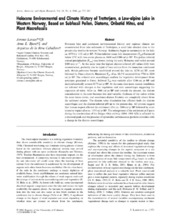Holocene environmental and climate history of Trettetjørn, a low-alpine lake in Western Norway, based on subfossil pollen, diatoms, oribatid mites, and plant macrofossils
Peer reviewed, Journal article
Published version
Permanent lenke
http://hdl.handle.net/1956/2557Utgivelsesdato
2006Metadata
Vis full innførselSamlinger
Sammendrag
Holocene lake and catchment environmental history and regional climate are reconstructed from lake sediments at Trettetjørn, a small lake situated close to the present-day treeline in western Norway. Sediments began to accumulate in the lake ca. 8575 (± 115) cal yr BP. Pollen-inferred mean July temperatures (Tjul) fluctuated below 12°C with two cooler phases ca. 8400 and 8200 cal yr BP. The pollen-inferred annual precipitation (Pann) was lowest during the early Holocene and varied around 1600 mm yr−1. At the same time the highest diatom-inferred pH values (6.8) were reconstructed, probably due to input of base cations from the immature catchment soils. Betula pubescens became established around the lake ca. 8270 cal BP, soon followed by Pinus sylvestris. Maximum Tjul of ca. 12.5°C occurred from 7760 to 5200 cal yr BP. The oribatid mite assemblages confirm the vegetation development from semiopen grassland to forest. Inferred Tjul was variable after 5200 cal yr BP and declined markedly around 4175 cal yr BP. At the same time more oceanic conditions are inferred with changes in the vegetation and mite assemblages suggesting the expansion of mires. After ca. 5000 cal yr BP and towards the present, the diatom concentration in the core becomes low and variable, thickness of the valves within the same taxon varies, and sometimes diatom frustules are completely absent from the sediment column. The diatom valve dissolution has affected both the diatom assemblages and the diatom-inferred pH up to the present-day. All proxies suggest that human impact affected the catchment after ca. 2000 cal yr BP followed by more intensive impact after ca. 1555 cal yr BP. The enlargement of the settlement at Upsete during the construction of the Bergen–Oslo railway (1894–1909 AD) is reflected by a charcoal peak and the presence of spheroidal carbonaceous particles coincides with a change in the diatom assemblages.
